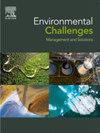Ecological dilemma: Invasive Gliricidia sepium improves carbon sequestration but decline diversity during secondary succession in tropical dry deciduous forest communities of Central India
Q2 Environmental Science
引用次数: 0
Abstract
Invasive species, the ecosystem engineers can act as one of the important solutions to curtail the negative impacts of climate change by rapidly sequestering CO2 in forests, due to their higher production function capability and survivability under extreme environmental conditions and/or nutrient poor soil. Assessment of their impacts on ecosystems, particularly in secondary forests could provide valuable insights on their usability in restoration programs during the present decade of ecosystem restoration. In the present study, we have assessed the impacts of invasive Gliricidia sepium on carbon sequestration rate and biodiversity during the secondary succession in forest communities by conducting field investigations in Gliricidia invaded and uninvaded secondary forests. Results of the present study showed that invaded forest community was significantly higher in stem density (1059.2 ± 37.94 individuals/ha), total biomass (94.45±10.27 Mg/ha) and carbon sequestration rate (8.01±1.50 Mg C/ha/yr) as compared to the uninvaded forest community. In invaded forest community, Gliricidia alone contributed 56.99 % to total biomass which is significantly higher than the other dominant and codominant species. Structural equation modelling clearly indicated that Gliricidia invasion had impacted carbon sequestration rate both directly and indirectly; however, the latter was mediated by stem density. In the present study, we found that second-growth forests invaded by Gliricidia although quickly accumulated carbon, it impeded biodiversity. We suggest that the plantation of invasive species might create obstruction to achieve the goals of REDD+ and UN resolutions on ecosystem restoration. Further, occupation of vacant niches by inducting early successional natives might act as an important way for sustainable ecosystem restoration.
生态困境:印度中部热带干燥落叶林群落次生演替过程中,入侵的黄蜡树(gliriicidia sepium)改善了碳固存,但降低了多样性
入侵物种具有较高的生产功能和在极端环境条件和/或养分贫乏的土壤下的生存能力,可以作为生态系统工程师通过在森林中快速吸收二氧化碳来减少气候变化负面影响的重要解决方案之一。评估它们对生态系统的影响,特别是对次生林的影响,可以为它们在当前十年生态系统恢复计划中的可用性提供有价值的见解。本研究通过野外调查,评估了入侵的毒舌藻对森林群落次生演替过程中碳固存率和生物多样性的影响。结果表明:入侵林群落的茎密度(1059.2±37.94个/ha)、总生物量(94.45±10.27 Mg/ha)和固碳率(8.01±1.50 Mg C/ha/yr)显著高于未入侵林群落;在入侵林群落中,单株占总生物量的56.99%,显著高于其他优势种和共优势种。结构方程模型清楚地表明,Gliricidia入侵对固碳速率有直接和间接的影响;而后者是由茎密度介导的。在本研究中,我们发现滑石霉入侵的次生林虽然迅速积累了碳,但却阻碍了生物多样性。我们认为,入侵物种的种植可能会阻碍REDD+和联合国决议关于生态系统恢复的目标的实现。此外,通过引入早期演替原住民来占领空缺的生态位可能是可持续生态系统恢复的重要途径。
本文章由计算机程序翻译,如有差异,请以英文原文为准。
求助全文
约1分钟内获得全文
求助全文
来源期刊

Environmental Challenges
Environmental Science-Environmental Engineering
CiteScore
8.00
自引率
0.00%
发文量
249
审稿时长
8 weeks
 求助内容:
求助内容: 应助结果提醒方式:
应助结果提醒方式:


